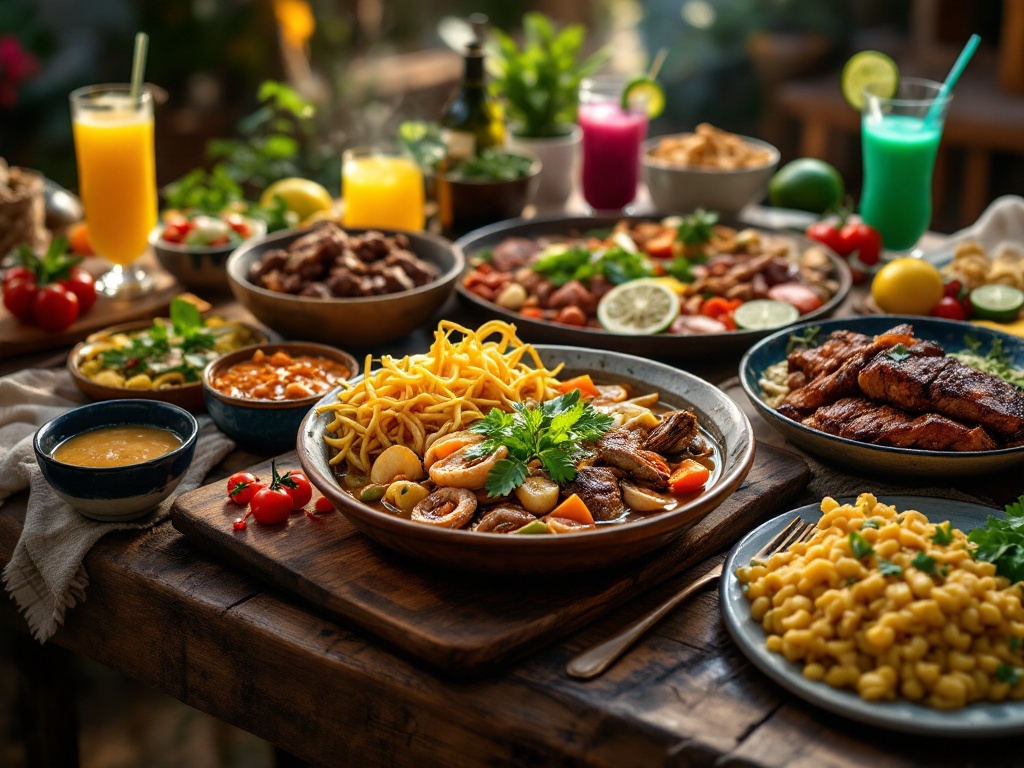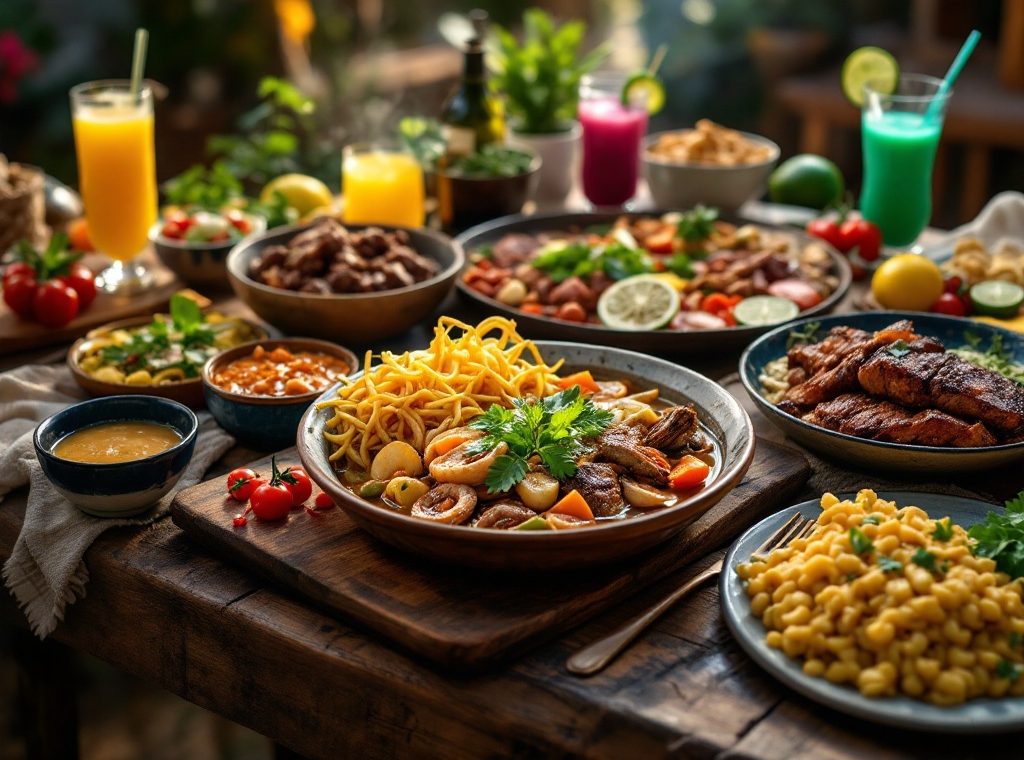What to Eat When Traveling to Brazil? A Foodie’s Guide to Brazilian Cuisine
Embark on a vibrant culinary adventure through Brazil, a melting pot of Indigenous, African, and European flavors! From the seafood-rich north to the hearty barbecues of the south, discover regional specialties like Moqueca and Churrasco. Explore iconic dishes such as Feijoada and Moqueca de Camarão, and savor street food delights like Coxinha and Tapioca. Dive into the rich culture with Caipirinha cocktails and refreshing Açaí smoothies. Uncover the diverse tastes of Brazil – read on to start your culinary journey!
Important information

- Brazilian cuisine is a mix of Indigenous, African, and European influences, creating diverse regional dishes.
- Feijoada, a black bean stew with various meats, is Brazil’s national dish.
- Churrasco, a barbecue of grilled meats, is a key part of Southern Brazilian culture.
- Popular street foods include coxinha (chicken croquettes), tapioca (cassava flour flatbread), and acarajé (black-eyed pea fritters).
- The caipirinha, made with cachaça, sugar, and lime, is Brazil’s national cocktail.
Introduction to Brazilian Cuisine: A Diverse Culinary Adventure
Brazilian cuisine is an explosion of flavors, a vibrant tapestry woven from Indigenous, African, and European culinary traditions. This fusion creates distinctive regional dishes, from the seafood-rich north to the hearty barbecues of the south. A culinary journey through Brazil is a foodie’s paradise, an exploration of diverse tastes and textures. Brazil’s multicultural heritage is the secret ingredient, ensuring every dish is a delicious discovery.
Understanding Regional Specialties in Brazilian Cuisine
Brazilian cuisine offers a vibrant tapestry of flavors, with each region contributing its unique culinary traditions. The North, blessed with abundant rivers and a vast coastline, is a haven for seafood enthusiasts. Indigenous and African influences add a touch of spice, evident in dishes like Moqueca, a rich fish stew simmered in coconut milk and dendê oil. In the South, gaucho culture reigns supreme, with churrasco, a barbecue feast of grilled meats, taking center stage. Mate tea, a beloved social drink, punctuates daily life. These regional specialties merely hint at the multifaceted nature of Brazilian cooking, a true melting pot of culinary influences.
Northern Flavors: Seafood and Spicy Treats
Northern Brazilian cuisine tantalizes taste buds with its unique flavors, often featuring fresh seafood. A prime example is Tacacá, a popular soup infused with tucupi and dried shrimp, and seasoned with jambu, a native herb. Spicy notes are a regional hallmark, reflecting the rich culinary heritage of Indigenous and African traditions. Chili peppers, ginger, and an array of herbs create bold, vibrant tastes. The Amazon rainforest also contributes distinct flavors to many regional dishes.
Southern Delights: Churrasco and Mate Tea
In Southern Brazil, churrasco isn’t simply a barbecue, it’s a beloved cultural experience. This culinary tradition revolves around grilling a variety of meats, such as beef, pork, and lamb. Complementing these savory offerings is mate, a caffeinated herbal beverage and social staple enjoyed throughout the day. It perfectly balances the richness of the churrasco.
Traditional Brazilian Dishes to Try
Feijoada, Brazil’s national dish, is a hearty black bean stew simmered with various cuts of pork and beef. It’s traditionally served with:
- rice,
- farofa (toasted cassava flour),
- collard greens, and
- orange slices.
Moqueca de Camarão, a Bahian shrimp stew, offers a rich and satisfying blend of flavors. The base consists of shrimp simmered in coconut milk with tomatoes, onions, and peppers. Dende oil (palm oil) and cilantro provide authentic depth.
Vatapá and Acarajé are two Bahian dishes with distinct African roots. Vatapá is a creamy paste made from bread, shrimp, peanuts, cashews, and coconut milk. It is often served inside Acarajé, a deep-fried black-eyed pea fritter. This fritter can also be filled with dried shrimp or caruru (okra stew), showcasing Bahia’s rich African culinary heritage.
Feijoada: The Black Bean Stew
Feijoada, a robust Brazilian stew, combines black beans with various meats like salted pork and beef. It’s a culinary tradition enjoyed on Wednesdays and Saturdays, served alongside rice, collard greens, and farofa (toasted cassava flour). This custom reflects the dish’s rich heritage, blending African, Portuguese, and Indigenous influences. Feijoada is proudly hailed as Brazil’s national dish, a staple in Brazilian homes.
Moqueca de Camarão: Shrimp Stew
Moqueca de Camarão is a flavorful Brazilian shrimp stew traditionally cooked in a clay pot, which adds a unique depth to the dish. Key ingredients include coconut milk, dendê (palm) oil, tomatoes, onions, and cilantro. While regional variations exist, particularly between Bahia and Espírito Santo, these core components remain consistent.
Vatapá and Acarajé: African Heritage on a Plate
Vatapá, a creamy paste made with bread, shrimp, peanuts, coconut milk, and palm oil, is a culinary staple. It is often served with acarajé, a fritter of black-eyed peas, onions, and salt. Together, these dishes showcase the significant African influence in Brazilian cuisine, particularly in Bahia.
Exploring Brazilian Snacks and Street Food
Brazilians savor savory snacks, called salgados, at any time of day. A prime example is coxinha, a deep-fried, teardrop-shaped pastry filled with shredded chicken, readily available from street vendors.
For a unique experience, try acarajé, a black-eyed pea fritter served split and filled with vatapá (a creamy paste of bread, shrimp, peanuts, coconut milk, and palm oil) and caruru (a flavorful okra stew).
Another street food staple, tapioca, offers a versatile crepe base for both sweet and savory fillings.
These salgados offer a delicious glimpse into Brazilian cuisine.
Salgados: The Anytime Snack
Brazilians savor salgados, delectable savory pastries enjoyed throughout the day. These baked or fried treats boast a diverse range of fillings, from savory meats and cheeses to vibrant vegetables. Some popular options include:
- Coxinhas, tear-shaped chicken croquettes.
- Risoles, similar in shape to coxinhas, but with a wider array of fillings.
- Empadas, small savory pies.
- Pastel, a larger fried or baked pastry.
Across Brazil, from bustling bakeries and cozy cafes to street vendors, these irresistible salgados are readily available.
Coxinha: A Favorite Street Food
Coxinha, a popular Brazilian street food, resembles a teardrop or drumstick. This crispy, golden-brown dough is filled with shredded chicken, often blended with cream cheese and aromatic spices, then deep-fried to a satisfying crunch.
Tapioca and Acarajé: Street Food Staples
Tapioca, a cassava flour flatbread cooked on a griddle, is a beloved Brazilian street food. Fillings range from sweet to savory. Another popular option is acarajé, a deep-fried black-eyed pea fritter often served with vatapá, a rich, creamy sauce. Both dishes highlight the diverse culinary traditions of Brazil, particularly in the northeast.
Brazilian Breakfast and Dining Culture
Brazilian breakfasts are simple yet satisfying. They often feature fresh tropical fruits like papaya, mango, and watermelon, alongside refreshing juices such as orange or guava. Pão de queijo, a delightful small cheese bread made from tapioca flour, is a breakfast staple, typically accompanied by strong, often sweetened, coffee. Some Brazilians also add ham, cheese, or buttered toast to their morning meal.Lunch is the main meal in Brazil, a significant occasion enjoyed between noon and 2 PM. A typical lunch plate includes rice, beans, and a choice of meat, such as beef, chicken, or fish. Salad and farofa, made from toasted cassava flour, are frequent accompaniments. Regional variations abound, incorporating local specialties and ingredients.
Buffets and “Quilo” Restaurants
For a taste of diverse Brazilian cuisine, buffets and “Quilo” restaurants offer flexibility and value. In “Quilo” restaurants, you pay by the weight of your chosen dishes.
Churrascarias
Churrascarias, or Brazilian steakhouses, provide another popular dining experience. They offer a unique and meat-centric feast.
A Typical Brazilian Breakfast: Fruits, Juices, and Pão de Queijo
Brazilians often begin their day with fresh fruit, such as Açaí, Guaraná, and Cupuaçu. Fresh juices blended with milk or water and served cold are another popular option. No Brazilian breakfast is complete without pão de queijo, the warm, cheesy bread enjoyed throughout the country.
Lunch: The Biggest Meal of the Day
Brazilians enjoy lunch as their main meal, a substantial repast typically comprised of rice, beans, a fresh salad, and a protein source such as meat or fish.
Dining Out: Buffets and Pay-Per-Kilo Restaurants
Brazil’s dining scene offers a unique culinary adventure. Many restaurants feature distinctive dining options, including “rodízio” style buffets and pay-per-kilo establishments, showcasing the diversity of Brazilian cuisine. At pay-per-kilo restaurants, you select your desired portions, and the final cost is calculated based on the total weight of your plate. Buffets, especially churrascarias (barbecue restaurants), offer an all-you-can-eat experience for a fixed price, allowing you to explore a wide range of Brazilian flavors.
Must-Try Brazilian Desserts and Sweets
Brigadeiro, a beloved Brazilian confection, resembles a rich chocolate truffle. Its simple recipe calls for condensed milk, cocoa powder, and butter, which are combined, rolled into balls, and coated in chocolate sprinkles. A true delight!
Cupuaçu, in contrast, is an exotic Amazonian fruit with a unique, slightly tart flavor, often likened to a blend of chocolate and pineapple. This versatile fruit finds its way into various desserts, from mousses and ice creams to cheesecakes and other sweet treats.
Brigadeiro: Chocolate Truffles
Brigadeiro, a cherished Brazilian delicacy, resembles a rich chocolate truffle. Surprisingly easy to make, these delightful sweets require only condensed milk, cocoa powder, butter, and chocolate sprinkles. A staple at Brazilian celebrations, they frequently appear at birthday parties and other festive gatherings, symbolizing the country’s warm hospitality.
Cupuaçu Desserts: Amazonian Flavors
Native to the Amazon, cupuaçu fruit offers a creamy texture and distinctive flavor, making it a popular choice for desserts. It’s a star ingredient in mousses, ice creams, and cheesecakes, but its versatility extends beyond sweet treats. Cupuaçu also enhances smoothies and juices, adding a delicious, unique twist. It’s also used in savory dishes sometimes.
Essential Brazilian Drinks to Experience
Brazil offers a vibrant array of beverages. Its national cocktail, the Caipirinha, is a delightful mix of cachaça, sugar, and lime. Fresh juices and smoothies are also popular choices, made with an abundance of tropical fruits like açaí, guava, and mango. For a refreshing experience, try coconut water, often sipped straight from the fruit on the beach.
Caipirinha: The Signature Cocktail
Brazil’s national cocktail, the caipirinha, is a simple yet refreshing blend of cachaça (a sugarcane-based liquor), sugar, and lime. It’s the perfect accompaniment to any meal.
Fresh Juices and Smoothies: Tropical Delights
Brazil’s tropical fruits offer a vibrant burst of flavor in fresh juices and smoothies. Açaí, cupuaçu, and guaraná are among the most popular choices, often blended with water or milk for a refreshing treat. These delicious beverages can be found at numerous juice bars and street stalls, providing a true taste of Brazil’s rich bounty. Discover the unique flavors of Brazil with these popular tropical fruit juices and smoothies:
- Açaí: Known for its deep purple color and slightly tart flavor, açaí is a nutrient-rich berry often blended into thick smoothies or enjoyed in refreshing juice form.
- Cupuaçu: With a creamy texture and a taste reminiscent of chocolate and pineapple, cupuaçu makes a decadent addition to smoothies and juices.
- Guaraná: This fruit boasts a slightly bitter, earthy flavor and is known for its energizing properties, making it a popular ingredient in stimulating juices and smoothies.
These beverages offer a true taste of Brazil’s rich bounty and can be easily found at numerous juice bars and street stalls.
Coconut Water: A Beachside Refreshment
On Brazilian beaches, coconut water is the ultimate refresher, perfect for beating the heat. Vendors sell fresh coconuts right on the sand, offering beachgoers a cool and hydrating escape.

















